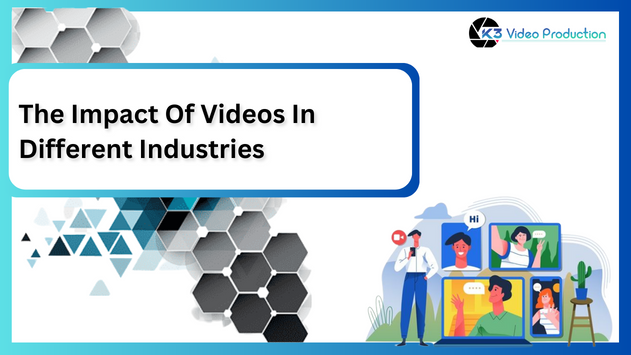In today’s society, videos are an effective medium for communication, interaction, and narration. They have an exclusive right to a short and strong visual communication. Altogether, such an impact has dramatically transformed videos in such areas like business operations, product promotion, consumer education, and customer relations. The use of the video production Baltimore has transformed how we practically engage and participate in several sectors which will be discussed in this blog post.
Table of Contents
ToggleBenefits of Videos In Different Industries
- Entertainment and Media: Videos have definitely impacted entertainment and media in numerous ways. Entertainment is not complete without video, especially in movies, television shows, music videos, or instant streaming services. They are informative and entertaining, taking viewers through an innovative and highly sensory journey. Netflix, YouTube and TikTok have revolutionized how media content is distributed and consumed by providing viewers direct access to content from independent producers.
- Marketing and Advertising: Integrated marketing communication and advertisement has made the use of videos a necessity in all fields of industries. They are effective instruments when it comes to grabbing attention, delivering specific brand messages and involving customers. One would also note that the engagement rate of video ads is higher than that of conventional formats of advertising. Social media like You Tube is quite ideal for organizations to convey their products and services. Video has become a miracle in creating marketing campaigns as it enables storytelling, product demonstrations, and evoking emotional appeal.
- Dynamic Marketing Campaigns: Chicago video production can help businesses transform conventional marketing strategies by creating engaging and aesthetically engaging content. It considered a significant element of the brand-storytelling and conversions because of its influencing power over human emotions.
- Immersive Product Demonstrations: They have assumed an essential part in altering the way different products are marketed and the manner in which potential customers are offered demonstrations. Whereas before we were only limited to pictures and simple text, business people are now in a position to advertise their products and services through professional and attractive videos, including features, utilities and how the products and services can be useful.
- Immersive Product Demonstrations: Videos have greatly revolutionized the manner in which products are showcased and how they are advertised to potential clients. Products and services can be sold using videos, which provide features, advantages, and how-to-use information instead of the text and images used earlier.
- Education and E-Learning: The education sector has benefitted from the existence of videos as we have seen. They can also be used to present educational content in a very interactive and interesting manner. With the help of videos, big ideas can be explained, knowledge is better retained, and learners engage in the process. Through e-learning platforms and online courses, individuals can watch videos in order to receive lectures, tutorials, or demonstrations in the aspect of education without geographical limitations. Videos meet the learners’ visual and auditory modalities and this makes learning easier for those with such preferred styles.
- Healthcare and Medicine: I learnt that video has revolutionized the healthcare and medicine industries. Patient information leaflets, medical training, and awareness raising campaigns employ them. It can be useful in portraying medical information that may be difficult to explain and also in creating awareness on health among patients. Surgeons and many other medical professionals take advantage of videos to explain new methods of operations, and the enhancement of procedures. Video conferencing has also been employed in bringing remote patients through telemedicine and other remote consultations.
- Real Estate and Architecture: Video has overturned the traditional method of displaying properties in the real estate and architecture industries. property virtual tours and 3D architectural virtualization services enable the potential buyers to get an actual feel of the properties without visiting them physically. The use of videos assists to capture the uniqueness of the features of homes, their designs and setting so that buyers can make educated decisions quickly. Architects and interior designers incorporate videos with their clients and evaluating their designs as a way of improving client appreciation.
- Transforming Recruitment and HR Practices: Interviewing and assessment in recruiting has dramatically changed with the application of videos. Video resume or job posting benefits the employers and in turn enables them to get to know the candidate better in terms of personality, communication, and culture match, thus facilitating the hiring process.
- Seamless Remote Collaboration: Modern workflow implies the use of video as a primary means of maintaining effective cooperation in distance environments. Interactions, as well as conferencing tools, allow employees to see each other physically and enhance collaboration and productivity for geographically dispersed workers.
- Travel and Tourism: In Relation to the travel and tourism industry, videos have been of immense value. It creates the desire to travel and plans for travel through interactive and virtual experiences where travelers cannot travel physically. They are employed in marketing by the travel agencies, hotels and even the tourism departments in the promotion of tourist attractions, sales of accommodations, and the display of tourist’s attractions and experiences. As a result, travel vlogs, and, in general, user-generated content on platforms such as YouTube have become the primary source of information for traveling lovers who depend on videos and testimonials.
- Disruption in the Entertainment Industry: Based on the importance of online videos, it is evident that they are the new paradigm for the entertainment industry. Regarding such streaming services as Netflix or YouTube, individuals have an opportunity to watch TV programs and diverse content in real time, on any device and at any time.
- Social Media Phenomenon: Video is perhaps the most influential content going viral on social media platforms, providing entertainment and conversation topics. Platforms such as TikTok and Instagram Reels cater to content creators and help users spread content among many people.
- Corporate Communications and Training: Pear videos have become popular in organizational communications and training tools and have increased employee participation and co-operation in organizations. Organizations have used corporate videos to pass on company values, new programs, and progress, to enhance awareness and synchronization. There is the case where internal training uses videos in onboarding, training proogram and sharings on best practices videos. Media consistency brings convenience to the learners as they can learn anytime and anywhere and the use of videos also encourage peer learning among employees.
- Nonprofit and Social Causes: In Search of Change and Reporting Information videos (Word Count: 225) Non-profit establishments and social causes have benefited from the use of the videos. They can express feelings, give emotions to an issue, and mobilize the emotions of the other people. Some examples of how nonprofits employ videos are; conveying their cause, presenting success narratives, and fundraising. Through the available social media accounts, nonprofit videos bring awareness to important causes and mobilize people across the world.
- Empowering Customer Support: Videos serve as instructional tools where customers can be guided through problem-solving processes in a practical manner. Self-help videos allow businesses to educate the customers on how they can resolve certain problems on their own, decreasing the number of support tickets and customer happiness.
Summing Up
Over the years, Video Production Chicago have transformed from being just a simple way of conveying information to a rich production tool that can be used in a variety of sectors. Vanguard’s consumption and interaction with videos changed many industries such as entertainment, media, marketing and advertisement, health care, real estate, travelling, corporate communication and nonprofit organizations. Over the years and particularly as technology advances, video will remain an important aspect to the future to future in different ways as it paves way for more innovations and revolutionize industries. Videos must be embraced by digital businesses and organizations to exist and play a crucial role in their operation.
FAQs
1. How have videos impacted the entertainment and media industry?
Videos have revolutionized the entertainment and media industry by becoming essential elements in movies, TV shows, music videos, and streaming services. Platforms like Netflix, YouTube, and TikTok provide direct access to a variety of content, enhancing both the distribution and consumption of media.
2. Why are videos important in marketing and advertising?
Videos are crucial in marketing and advertising because they effectively grab attention, convey brand messages, and engage customers. They enable storytelling, product demonstrations, and emotional appeals, resulting in higher engagement rates compared to traditional advertising formats.
3. How do videos enhance product demonstrations?
Videos provide immersive product demonstrations by showcasing features, benefits, and usage instructions more effectively than text and images. This visual and dynamic approach helps potential customers better understand and appreciate the product or service.








